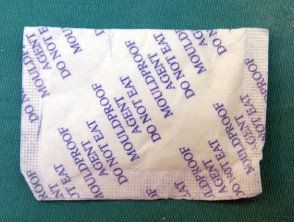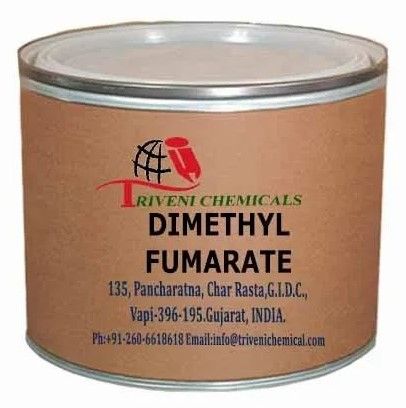Dimethyl fumarate
Dimethyl fumarate (DMF) is a dangerous chemical that has been banned in several countries, but it is (wrongly) still allowed in the U.S.
In fact, the manufacture of products with DMF in the European Union has been banned since 1998, and imports of products with DMF (to the European Union) have been banned since 2009.
People can be exposed to DMF through these routes of exposure:
- Leather used to make furniture is often treated with DMF with the alleged purpose of reducing moisture and mold.
- DMF is also included in millions of desiccant packets/sachets (see a sample picture in the next column) that are included in leather goods, shoes, riding helmets, non-leather furniture, etc. These desiccant packets/sachets are made of breathable fabric and contain a white crystalline powder (DMF).
- DMF is released through vapors and infects/contaminates these items and can also contaminate other nearby furniture and household items and clothing of the person who sits on the contaminated item.
Many (or maybe all) furniture companies in the U.S. use DMF to treat their furniture and household goods. This is wrong, and DMF should be banned in the U.S.
As one example, a popular leather theater seating company in the U.S. uses DMF in their sachet packets, so you will be bringing this dangerous chemical into your home.
Buyer beware!!
It is difficult to avoid DMF because products are not identified as containing the substance. However, sachets labelled “mould inhibitor” or “anti-mould” are likely to contain DMF and should not be touched.
WARNING: Furniture stores and other companies will not tell you if they use DMF in their leather products or in their desiccant packets (sachets).
Furniture with DMF cannot be "cleaned."
The furniture stores will tell you to clean the sofa, recliner, etc. with leather cleaner. That will NOT work.
The only way to get rid of the contamination is to get rid of the furniture.
Even then, the chemical can linger in the air after the item has been removed and will contaminate nearby fabrics such as other furniture items in the same room and clothing worn by the person who sits on the contaminated item.
Dimethyl fumarate is also known as fumaric acid, dimethyl ester, allomaleic acid dimethyl ester, dimethyl (E)-butenedioate and methyl fumarate.
DMF is a potent irritant and sensitizer, which is capable of causing acute and severe contact irritation following exposure to it. The symptoms typically comprise an itchy, scaling or papulovesicular rash, which is reddened and swollen. The areas affected are commonly the back, the posterior aspect of the legs and the arms, the genitals and the buttocks -- all of which come into contact with the furniture.
Numerous cases of dermatitis induced by dimethylfumarate (DMFu) have been reported in Europe. DMFu has been used to prevent mold development in various items, although it is not registered as a biocide.
In France, from October 2008 to December 2009, hundreds of cases were reported. Despite a ban on articles containing DMFu and the removal of potentially contaminated products, some people were still suffering from dermatitis or other health problems.
There are many research papers regarding the dangers of DMF. Here are a few excerpts:
Exposure was assessed by measuring DMFu in items sampled in pre-selected dwellings. These investigations demonstrated that DMFu exposure can persist after removal of the primary contaminated items. Read this research paper.
Dimethyl fumarate (DMF) is a chemical compound which has been added to silica gel bags used for preserving leather products during shipment. DMF has recently been singled out due to its ability to induce a number of medical problems in people which touch products contaminated by it. Read this research paper.
Dimethylfumarate (DMF) was the cause of a major outbreak of allergic contact dermatitis as a consequence of its use as an antifungal agent in leather products, particularly in furniture. The media referred to this outbreak as "toxic sofa dermatitis."
The widespread effects of this major outbreak for thousands of people in several countries generated the ‘perfect storm’ conditions that caused the DMF epidemic.
Read this research paper.
GIHN note: This effect should actually be referred to as a chemical sensitization (or a reaction to the DMF chemical) and contact dermatitis. This is NOT an allergy.
It is important to keep in mind that there are many firsthand reports and patient experience that show that limited exposure for even a few minutes can also cause a severe reaction.

Dimethyl Fumarate (DMF) is a harmful chemical that is used in sachets to prevent mold growth in leather goods and is also used in other non-leather consumer items.

Dimethyl fumarate (DMF) is a dangerous chemical that has been banned in several countries, but it is (wrongly) still allowed in the U.S.
Treatment for patients harmed by DMF
The most important step is to STOP THE EXPOSURE.
The contaminated item must be removed from the home. In addition, because the chemicals can linger in the air, the affected person may have to leave their home for several days or weeks and have the house thoroughly cleaned and de-contaminated. Keep in mind that nearby furniture/porous items could have absorbed some of the vapors, so you may need to get rid of those items too.
The affected person should see their physician who will decide the best course of action based on the severity of their symptoms and their medical history.
For example, if the rash is mild to moderate, the physician may recommend Epsom salt baths and/or cortisone cream. Emollients are useful to soften the skin and ease the scaling.
If the rash is more severe, the physician could prescribe oral steroids or hospitalization.
As a reminder, this is NOT an allergy or allergic reaction. It is a reaction to a chemical, so allergy shots would be unnecessary and ineffective.
Read this paper.